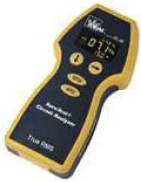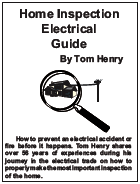- Certified Chief Electrical Inspector
Building Officials of Florida
- Certified Chief Electrical Inspector
Southern Building Code Congress
- Former Electrical Inspector Walt Disney
World - EPCOT
- Registered Electrical Contractor State of
Florida
- Licensed Master Electrician
- Member National Fire Protection
Association (NFPA)
- Member International Association of
Electrical Inspectors (IAEI)
- Owner of Code Electrical Classes Inc.
Winter Park, FL.
- Certified Vocational Instructor State of
Florida
- Instructor of over 28,000 Electricians
- Author of Electrical Inspection Workbook
- Author of over sixty Electrical books
- Legal consultant involving Electrical
fires and deaths
- Over 62 years experience in the
Electrical Field
- Electrical construction editor for the
"Informer" newsletter
- President of Tom Henry's "Learn to be an
Electrician" program with over 1900 enrolled from all 50 states and
several foreign countries
Home Inspection
Electrical Guide
By
Tom Henry
Having over 62 years in the electrical
trade and the
experiences I've had during this journey, I feel obligated to share
them in this book to make the home a safer place to live.
Electricity has been a permanent feature in residential occupancies for
over 100 years, and it was known to be a cause of fires since the
earliest days of its use. I have personally spent many hours sifting
through debris after a fire, and I have witnessed homeowners who
experienced an electrical fire firsthand in their homes.
This book was NOT written as a step by step guide of how to make a
total electrical inspection, but rather as a guide to make certain the
Home Inspector is not overlooking the critical areas that have started
fires and caused accidents.
Why is fixed wiring
the leading cause of a residential electrical fire? This book will not
only take you to the causes, but also show the solutions of preventing
an electrical fire before it starts with a proper electrical inspection
of the home.
It's your moral obligation to provide the upmost in
electrical safety to the homeowner.
Experienced
investigators uniformly cite high-resistance connections as the most
common electrical cause of fires. It has been estimated that
90% of
electrical
failures occur at
connections. Loose wire connections at the
receptacle outlets and switches are a common reason for an electrical
fire in a residence.
Recent studies have shown
that the frequency of fires in residential electrical systems is
disproportionately higher in older homes. Three factors that could
influence the likelihood of a residential electrical fire are; 1) the
effects of natural aging over time on the electrical system wiring and
equipment, 2) misuse or abuse of the electrical system components in
the home by occupants, and 3) non-Code compliant installations,
upgrades, or repairs.
Although many homes have
had their electrical system upgraded or expanded over the years, many
also have not. The electrical wiring within the home may be the most
vulnerable to aging, as it is often buried in walls or ceilings, or
installed in attics or crawl spaces that are often not used. In
addition, these nonclimate controlled areas, like attics and crawl
spaces, can be subjected to extreme temperature conditions and changes,
as well as dampness and moisture. All of these factors can contribute
to, or even accelerate, the effects of aging.
FIRES
WITHIN THE WALLS
A fire, originating in a room, would
have to
rage for a half hour or more before it burnt itself into a wall, during
which time smoke alarms and occupants would have detected the
fire
in ample time to extinguish it or escape. Roughly one-third of all
fires began in concealed or other normally vacant spaces. Short circuit
arcs resulting from defective or worn insulation, were the leading
specific failure cited for 21% of the fires, and the leading item first
ignited was electrical wire or cable insulation.
 |
It's impossible to see inside these walls when making an
inspection. Today there is a proven tester that shows the impedance
(resistance) of the entire circuit which includes the receptacle, the
building wiring, the panel box, the meter - all the way to the
transformer on the utility pole. If there is a high resistance in any
connection in that circuit due to a bad splice or loose connection, or
because of a damaged conductor, its condition will be revealed in this
test. |
After using this
tester for eight months, the National Association of Home Builders
Research Center stated "Because the SureTest is able to quickly and
safely apply a full load test to the circuit, we can test all circuits
in a house for hidden, sometimes deadly, flaws within minutes".
Based on the availability and ease of use of this test, the Consumer
Product Safety Commission recommended inclusion of the 15 ampere load
test in NFPA 73, the inspection procedure for one and two-family
dwellings.
SureTest circuit analyzers were sent
to electrical inspectors in 250 municipalities throughout the U.S. for
a 30-60 day evaluation, resulting in an overwhelming acceptance of the
load test.
More than 90% of the inspectors who evaluated the hand-held
load testers, purchased them after the evaluation period, and indicated
their intention to integrate the load test into their inspection
procedures.
As a troubleshooting tool, the load
test can save hours of time trying to locate the source of a problem.
Simple to use, the load tester identifies branch wiring deficiencies
and isolates hazards as the inspector moves along the branch circuit.
Like a divining rod dowses for water, the load tester "points" to
wiring deficiencies and receptacle hazards.
A
well-executed home inspection combines broad technical knowledge of the
electrical system with an ability to communicate technical issues in
terms that a layperson can understand. This book was written in an easy
to understand format.
While working as an
electrical expert in a personal injury or death case I had to explain
to the jury in simple terms as they were not electricians. The water
analogy is used to explain electrical terms. The water pressure is the
voltage, the flow of water is the amperage, the restriction in a water
pipe is the resistance, and the wattage is the work being done as the
sprinkler system is spraying the water on the lawn. The wattage is what
you are paying for. I'll take you a walk through electricity in easy to
understand terms as I did before the jury in a personal injury or death
case using the water analogy.
In my journey
having prepared over 28,000 electricians for their license with
seminars in over 21 states and working for years as an electrical
expert in personal injury and death cases I have heard and witnessed
many tragic stories of electrical accidents. When you see children
burnt to ash from an electrical fire it becomes a responsibility to
pass the education on in hopes that it never happens again.
My hope is that after reading this book you will sell the idea to a
homeowner that older homes need to be inspected NOW, not waiting for a
resale. After reading this book
you will know how to STOP the fire
before it starts!
If you're going to be a home
inspector, don't just be average.
Be the best inspector you can be and
make the most important safety inspection in the home properly. The
more we learn, the better we are as a professional inspector.
 |
The
quality of American life depends upon the safety and
effectiveness of electrical
application and inspection.....
|
 |
The 14 chapters are: History, Code Violations, The Service,
Grounding, Overcurrent Protection (circuit breaker or fuse),
Receptacles, Flexible Cords, Wiring, Electricity, The Circuit, Voltage
Drop, Loose connections, AFCI, Summary. 149 pages |
 |
The
two DVDs have approximately 3 hours of demonstrations of appliance
overloads, cord and receptacles short circuits, the actual time it
takes for a circuit breaker and fuse to open under the same conditions
with an overload and short circuit, branch circuits being load tested
with the circuit analyzer, over 35 demonstrations, etc... A wealth of
electrical education in this program with Tom and Tim Henry.
For a brief sample go to:
http:youtu.be/_-FUZMPujVA |
 |
On
the video you'll see Tim Henry demonstrate the circuit analyzer in
action and soon realize what a valuable tool it is in locating the
loose connections and preventing a fire before it starts. It will
indicate the resistance of each wire and show the voltage drop. You'll
see how one receptacle that had the wiring back-stabbed was corrected
by wrapping the wire around the screw and by torquing the connections
it reduced the voltage drop 1.8% by correcting the connections on ONE
receptacle. |
RECEPTACLE
CONTACT PRESSURE TESTER
 |
Receptacle performance is only as good as the electrical and
mechanical contact maintained within the blades of the attachment plug.
The first point of wear in a receptacle is usually the tension of the
spring contacts.
Any reading by this instrument above 4 oz.
indicates a serviceable receptacle, that all plugs will fit well.
After 10 years you will find receptacles that are
often used where the contact blade is worn out and the receptacle needs
to be replaced. The tester is insulated to be plugged into an energized
circuit so it doesn't take long to check all the receptacles. |
 |
ITEM
#903 Home Inspection Electrical Guide is
sold only as a program which includes one Home Inspection Electrical
Guide book, two DVDs (total approximately 3 hours) with Tom and Tim
Henry and 35 demonstrations filmed.
$79 